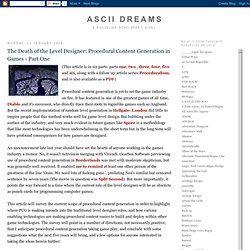

The death of the Level Designer [PDF] Part One - The Death of the Level Designer: Procedural Content Generation in Games. (This article is in six parts: parts one, two , three, four, five and six, along with a follow up article series Proceduralism; and is also available as a PDF) Procedural content generation is yet to set the game industry on fire.

It has featured in one of the greatest games of all time, Diablo and it's successor, who directly trace their roots to roguelike games such as Angband. But the recent implementation of random level generation in Hellgate: London did little to inspire people that this method works well for game level design. Part Two - The Death of the Level Designer: Procedural Content Generation in Games. (You probably want to start with part one of this article). 4.

Instancing of in-game entities Most games hide the enemies faces. This is a natural consequence of the fact that humans naturally look at faces to distinguish individuals, and designing or video capturing a new face for each potential enemy in a game can be a long and exhausting process. Consider a game engine that is automatically capable of generating a large number of faces based on a set number of parameters. But this is not just limited to individual faces. Any why stop at goblins? 5. You can go one step further than SpeedTree, and instance all the game vegetation, so you'll never run into the same tree twice. This mechanic is very similar in concept to that used in Spore. This process is extremely powerful. 6. Part Three - The Death of the Level Designer: Procedural Content Generation in Games. You'll want to read parts one and two first) Every so often, someone rediscovers procedural content generation and for a moment sees it as the solution to their game development worries.

The latest last crisis was in the increasing cost in delivering triple A games on console platforms, and procedural generation was going to magic this cost away by making content free. Googling for 'procedural content generation' is like looking through a slightly forlorn graveyard - it's sunny and the textured head stones look beautiful in the evening light, but ultimately it's not as full an after-life as you anticipated. Why has PCG failed to deliver on the promised hype? Firstly, procedural content generation algorithms are hard. You are no longer looking at simple test cases in resolving issues with PCG. Consider that dynamic AI is a sub-set of PCG, and the promises of AI are consistently five years away on delivering, if not longer. 1. 2. 3. 4. 5. Part Four - The Death of the Level Designer: Procedural Content Generation in Games.
(You'll want to read parts one, two and three first) It's January 2013.

The Christmas games embargo that the Clinton administration put in place to ensure you saw friends and family over the holiday season has been lifted, and you excitedly unwrap the plastic from your lastest purchase: Dream Park 2.0. You've already heard about the great mods created by international players working on behalf of Gamers Now United (Stallman's reorganisation of the former Open Source movement once he finally succumbed to playing World of Warcraft), and you download a pre-recommended pack from your Facebook game reputation system.
The game fires up, and you click through the menus making a few choices and letting the RNG choose the rest. Medieval. Part Five - The Death of the Level Designer: Procedural Content Generation in Games. (You'll want to read parts one, two , three and four first) There's two kinds of hard - I'll call them depth and complexity.

Depth is similar to what I think Dwarf Fortress does for it's random world generation - it requires that you come up with e.g. a list of every possible type of mineral, multiple 'layers' of level generation such as height, moisture, temperature and combine these all. The building blocks however are relatively simple - some kind of fractal subdivision, working out which combination of height, vegetation, temperature etc result in plains, swamps and so on.
Complexity includes problems however that there is no possible solution for, or the solution cost rapidly increases out of bounds. Things like the Travelling Salesman problem, placing rooms and corridors in some kind of ordering, etc. To compare the two, most naive AI routines are complex rather than deep. Dwarf Fortress achieves the depth problem probably better than anyone else. Part Six - The Death of the Level Designer: Procedural Content Generation in Games. (You'll want to read parts one, two , three, four and five first) The human brain has a powerful set of tools for detecting and matching useful patterns in otherwise chaotic data.

This set of tools can be conditioned to override normal behaviour patterns in the presence of sufficiently powerful and randomly provided incentives: so-called operant conditioning. You will have probably seen the term 'Skinner box' associated with certain types of game-play: in particular with MMORPGs and slot machines, where people become addicted to randomly provided rewards for repetitive activity.